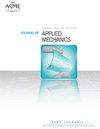利用声激励在薄壁结构中产生几何缺陷
IF 2.8
4区 工程技术
Q2 MECHANICS
引用次数: 0
摘要
细长薄壁结构构件的热力学屈曲在没有预警的情况下发生,可能导致灾难性的破坏。在质解(植物原生质体的收缩)和病毒衣壳的破裂过程中也观察到类似的现象。从弹性板、圆柱和壳的稳定性分析中得出的分析公式,如果没有考虑到在制造过程或生物生长过程中引入的随机几何缺陷的影响,可能会大大高估屈曲能力。因此,为了确保结构安全,这些公式必须与经验数据相结合,以确定“击倒因子”,然后再用于建立安全系数。为了更好地理解缺陷对机械响应的作用,人们采用了巧妙的方法来制造和测试近乎完美的半球形外壳和含有韧窝状缺陷的外壳。然而,一种以随机形状表面的形式诱导缺陷的方法仍然难以捉摸。我们介绍了一种实现这种不完美外壳的协议,并测量了使它们弯曲所需的压力。在声音激励下,将硅树脂倒入弹性体模具中,声音激励可以是随机声音,也可以是与模具模态频率相同的声音。近完美壳和不完美壳的微计算机层析成像和屈曲压力实验表明,该方法在引入显著大小的随机形状缺陷方面是有效的。这一概念验证研究表明,当实验结果与计算模拟相结合时,可以提高对随机屈曲现象的理解。本文章由计算机程序翻译,如有差异,请以英文原文为准。
Creating Geometric Imperfections in Thin-Walled Structures using Acoustic Excitation
Thermomechanical buckling of slender and thin-walled structural components happens without warning and can lead to catastrophic failure. Similar phenomena are observed during plasmolysis (contraction of a plant cell’s protoplast) and rupture of viral capsids. Analytical formulas derived from stability analyses of elastic plates, cylinders, and shells that do not account for the effects of random geometric imperfections introduced during the manufacturing process or biological growth may vastly over-estimate buckling capacity. To ensure structural safety the formulas must therefore be combined with empirical data to define “knock down factors” which are in turn used to establish safety factors. Towards improved understanding of the role of imperfections on mechanical response, ingenious methods have been used to fabricate and test near-perfectly hemispherical shells and those containing dimple-like defects. However, a method of inducing imperfections in the form of randomly-shaped surfaces remains elusive. We introduce a protocol for realizing such imperfect shells and measuring the pressure required to buckle them. Silicone is poured onto an elastomeric mold under an acoustic excitation, which can be either random sound, or if desired the same as the modal frequency of the mold. Illustrative micro-Computed-Tomography images and buckling pressure experiments of a nearly-perfect shell and an imperfect one show that the method is effective in introducing randomly-shaped imperfections of significant magnitudes. This proof-of-concept study demonstrates that the experimental results when combined with computational simulations can lead to improved understanding of stochastic buckling phenomena.
求助全文
通过发布文献求助,成功后即可免费获取论文全文。
去求助
来源期刊
CiteScore
4.80
自引率
3.80%
发文量
95
审稿时长
5.8 months
期刊介绍:
All areas of theoretical and applied mechanics including, but not limited to: Aerodynamics; Aeroelasticity; Biomechanics; Boundary layers; Composite materials; Computational mechanics; Constitutive modeling of materials; Dynamics; Elasticity; Experimental mechanics; Flow and fracture; Heat transport in fluid flows; Hydraulics; Impact; Internal flow; Mechanical properties of materials; Mechanics of shocks; Micromechanics; Nanomechanics; Plasticity; Stress analysis; Structures; Thermodynamics of materials and in flowing fluids; Thermo-mechanics; Turbulence; Vibration; Wave propagation

 求助内容:
求助内容: 应助结果提醒方式:
应助结果提醒方式:


